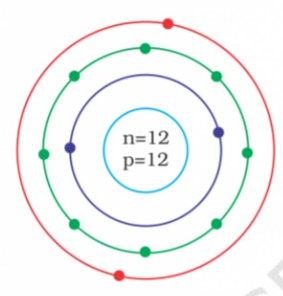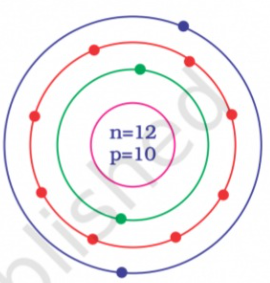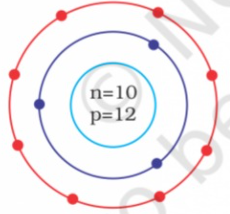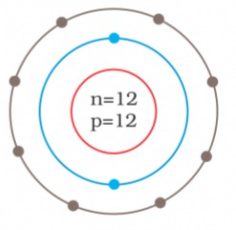Identify the Mg2+ ion from the figure where, n and p represent the number of neutrons and protons respectively.




The correct Answer is:D
To identify the Mg2+ ion from the given figures, we can follow these steps:
Step 1: Understand the Atomic Structure of Magnesium
- The atomic number of magnesium (Mg) is 12. This means it has 12 protons (p = 12).
Step 2: Determine the Number of Neutrons
- The mass number of magnesium is given as 24. The mass number is the sum of protons and neutrons.
- Therefore, the number of neutrons (n) can be calculated using the formula:
\(
\text{Mass Number} = \text{Number of Protons} + \text{Number of Neutrons}
\)
\(
24 = 12 + n \implies n = 24 - 12 = 12
\)
- Thus, magnesium has 12 neutrons.
Step 3: Analyze the Mg2+ Ion
- The Mg2+ ion indicates that magnesium has lost 2 electrons.
- The electronic configuration of neutral magnesium is K2L8M2, which means it has 12 electrons.
- After losing 2 electrons, the electronic configuration of Mg2+ becomes K2L8, which means it now has 10 electrons.
Step 4: Confirm the Number of Protons and Neutrons in Mg2+
- The number of protons remains the same (12) because the atomic number does not change.
- The number of neutrons also remains the same (12) since losing electrons does not affect the number of neutrons.
Step 5: Identify the Correct Option
- Now, we need to find the figure that represents Mg2+ with 12 protons and 12 neutrons.
- Look for an option where the number of protons (p) is 12 and the number of neutrons (n) is also 12.
Conclusion
- The correct option that corresponds to the Mg2+ ion is the one where both the number of protons and neutrons are equal to 12. This is represented by option D.
---
- The atomic number of magnesium (Mg) is 12. This means it has 12 protons (p = 12).
- The mass number of magnesium is given as 24. The mass number is the sum of protons and neutrons.
- Therefore, the number of neutrons (n) can be calculated using the formula:
\(
\text{Mass Number} = \text{Number of Protons} + \text{Number of Neutrons}
\)
\(
24 = 12 + n \implies n = 24 - 12 = 12
\)
- Thus, magnesium has 12 neutrons.
- The Mg2+ ion indicates that magnesium has lost 2 electrons.
- The electronic configuration of neutral magnesium is K2L8M2, which means it has 12 electrons.
- After losing 2 electrons, the electronic configuration of Mg2+ becomes K2L8, which means it now has 10 electrons.
- The number of protons remains the same (12) because the atomic number does not change.
- The number of neutrons also remains the same (12) since losing electrons does not affect the number of neutrons.
- Now, we need to find the figure that represents Mg2+ with 12 protons and 12 neutrons.
- Look for an option where the number of protons (p) is 12 and the number of neutrons (n) is also 12.
- The correct option that corresponds to the Mg2+ ion is the one where both the number of protons and neutrons are equal to 12. This is represented by option D.
Similar Questions
Knowledge Check
An electron and a proton are detected in a cosmic ray experiment, the first with kinetic energy 10 keV, and the second with 100 keV. The ratio of their speeds is
(where me and mp are masses of electron and proton respectively)A√110mempB√110mpmeC110mempD110mpme
A radioactive nuclide emits γ-rays due to
a. K-electron capture
b. Nuclear transition from higher to lower energy
c. Presence of greater number of neutrons than protons
d. Presence of greater of protons than neutrons
View SolutionFor an element , if atomic number (Z) and mass number (A) are 29 and 63 respectively . Then the number of protons , neutrons and electrons respectively are :-
View SolutionThe number of protons, neutrons and electrons in 175_71 Lu , respectively, are:
View SolutionIf ni, ne and nh represents the number of intrinsic charge carrier, number of free electrons and number of holes respectively in semiconductor, then relation nhne=n2i is true for
View SolutionIdentify 'a' and'b' in the figure given below representing proportionate number of major vertebrate taxa.
View SolutionThere exists a uniform electric field between plates A and B. An electron and proton, initially at rest are released from plates A and B respectively. If ae and ap stand for the acceleration of electron and proton respectively then
View SolutionAtomic number and mass number of an element M are 25 and 52 respectively. The number of electrons, protons and neutrons in M+2 ion are respectively.
View Solution